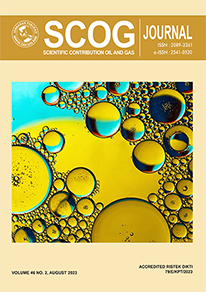SYNTHESIS AND EVALUATION OF SULPHONYL BORATE ESTER AS GREASE ADDITIVE
DOI:
https://doi.org/10.29017/SCOG.46.2.1553Keywords:
Lubricating Grease, Extreme Pressure, Sulphonyl-Borate ester, Dropping point, Friction ModifierAbstract
This study includes synthesis and evaluation of an additive to improve the two main properties of lubricating grease which are; “increasing the dropping point and improving the extreme pressure (EP) properties†of Lithium grease without any negative effect on the other characteristics of lubricating grease. Increasing the dropping point and extreme pressure (EP) properties are the most important factors to widen the application of lubricating grease. The additive is synthesized via two-steps condensation reactions of polyethylene glycol 400 and Boric acid followed by reacting the product with Dodecyl-benzene sulfonic acid in the presence of Xylene as azeotropic solvent. The structure of the synthesized Sulphonyl-Borate ester SPB is confirmed by using FT-IR. Evaluation of the synthesized additive is conducted by blending it with laboratory prepared Lithium grease sample in different ratios. Analysis were carried out to study the effect of additive on the lubricating grease properties, especialy grease consistency ASTM D217, dropping point ASTM D2265, oil separation ASTM D6184, and Four–Ball test ASTM D2783. The results showed that synthesized additive increased the dropping point by 65 % and extreme pressure properties by 66 % of the prepared grease grease sample.
References
ASTM Book of Standards – section 5; 2022
Deshmukh, Vijay, et. al. “Evaluation of Boron Esters in Lithium Complex Greases Prepared with Hydrogenated Castor Oilâ€; NLGI Spokesman, 80(4), September-October, 2016, p 42
Fagan, Gian L. “Continuous Lithium Complex Grease Manufacturing Process with a Borated Additiveâ€; U.S. Patent No. 9,167,045, 2015.
Fish, Gareth, et. al., “Lubricating Grease Thickenersâ€; “How to Navigate Your Way Through the Lithium Crisisâ€; NLGI 84thAnnual Meeting, Olympic Valley, CA, June 12, 2014
He, Z.Y.; Xiong; L.P., Qian, L.; Han, S.; Chen, A.X.; Qiu, J.W. and Fu, X.S.; “Lubrication Scienceâ€, 2014
John J.; Lorimor. “An Investigation into the use of Boron Esters to improve the High-Temperature Capability of Lithium 12-Hydroxystearate Soap Thickened Greaseâ€, Presented at the NLGI 76th Annual Meeting Tucson, Arizona, USA June 13-16, 2009
Kassman Rudolphi, Elisabet Kassfeldt, Marikta Torbacke; “Lubricants Introducttion to properties and performance†, 2014
Milda Fibria, Setyo Widodo, dan Endah Juwita M.; “The Dissolution Ratio LiOH in Water and Their Effect to The Grease characteristicsâ€, Scientific Contributions Oil and Gas LEMIGAS J. Vol. 49 No.1 April 2015.
Nakamoto, K.; “Infrared and Raman Spectra of Inorganic and Coordination Compoundsâ€, 2009
Pokhriyal, Vennampalli M., et. al. “Exploratory Studies on Borate Esters as Dropping Point Enhancersâ€; NLGI Spokesman, 83(2), May-June, 2019
Ratu Ulfiati; “formulation of lubricating grease for agricultural equipment applicationâ€. Scientific Contributions Oil and Gas LEMIGAS J. Vol. 39, Number 1, April 2016
Riemenschneider, W.; “Organic Esters, in Ullmann’s Encyclopedia of Industrial Chemistryâ€, 1987
Setyo Widodo, M. Hanifuddin, and Rona Malam Karina; Tribological properties of mineral base oils with tungsten disulphide (WS2) nanoparticles in boundary lubrication conditions, Scientific Contributions Oil and Gas, LEMIGAS J. Vol. 39, Number 2, August 2016
Siegart, William R. and Henry, Clemence J., USP 3,125,526, March 16, (1964)
Sing, G.I.; H.; and Kuhn, E.; “Systematic Effects on the Precision of Penetration Readings a Contribution to the Rheology of Lubricating Greasesâ€, Eurogrease, 1997.
Spikes, H.;†Lubrication Scienceâ€; 2008
Wilfried Dresel, Theo Mang; “Lubricant and Lubricationâ€, 2017
Yan, J.; Zeng X.; Heide, E. and Ren, T., “Tribology Internationalâ€; 2014
Downloads
Published
Issue
Section
License
Copyright (c) 2023 © Copyright by Authors. Published by LEMIGAS

This work is licensed under a Creative Commons Attribution 4.0 International License.
Authors are free to Share — copy and redistribute the material in any medium or format for any purpose, even commercially Adapt — remix, transform, and build upon the material for any purpose, even commercially.
The licensor cannot revoke these freedoms as long as you follow the license terms, under the following terms Attribution — You must give appropriate credit , provide a link to the license, and indicate if changes were made . You may do so in any reasonable manner, but not in any way that suggests the licensor endorses you or your use.
No additional restrictions — You may not apply legal terms or technological measures that legally restrict others from doing anything the license permits.














